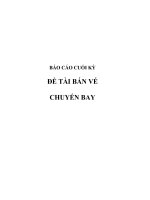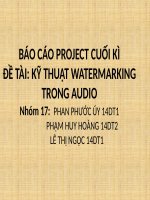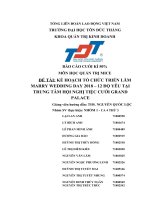Báo cáo cuối kì report final project temperature sensors
Bạn đang xem bản rút gọn của tài liệu. Xem và tải ngay bản đầy đủ của tài liệu tại đây (3.98 MB, 17 trang )
<span class="text_page_counter">Trang 1</span><div class="page_container" data-page="1">
TRƯỜNG ĐẠI HỌC SƯ PHẠM KỸ THUẬT TP.HỒ CHÍ MINH
<b>VIỆN SƯ PHẠM KĨ THUẬT</b>
SUBJECT: SENSORS AND ACTUATORS
<i>REPORT FINAL PROJECT:</i>
<b>TEMPERATURE SENSORS</b>
<b> Instructor : Hà Lê Như Ngọc Thành, Ph.D. Group: 02</b></div><span class="text_page_counter">Trang 2</span><div class="page_container" data-page="2"><b>Table of Contents</b>
<b>1.Learn about temperature sensors...3</b>
<b>1.1.What is temperature sensor...3</b>
<b>1.2. Working principle of temperature sensor...3</b>
<b>1.2.2. RTD –( Resistance Temperature Detectors)...4</b>
<b>2. Temperature sensor LM35...5</b>
<b>2.1.What is LM35?...5</b>
<b>2.2. Pinout of temperature sensor LM35...5</b>
<b>2.3. Specifications of the LM35 sensor...6</b>
<b>2.4. Working principle of temperature sensor LM35...7</b>
<b>2.5. Types of temperature measuring circuits...7</b>
<b>2.6. Steps to calculate temperature by temperature sensor LM35...8</b>
<b>3. Experimental results lm35 sensor...8</b>
<b>4.Application of LM35 sensor...12</b>
<b>5. Conclusion...15</b>
</div><span class="text_page_counter">Trang 3</span><div class="page_container" data-page="3"><b>1.Learn about temperature sensors1.1.What is temperature sensor</b>
A temperature sensor is an RTD (resistance transducer) device or a thermocouple that measures the change in temperature of the object to be measured. When the temperature has a large change, the sensors will give a signal, from which the reader will read and convert to a specific number. Thermal sensor devices are used in environmental control of HVand AC systems, chemical processing, food processors, medical equipment, ... through the monitoring system of the hood.
Currently, the most commonly used type of sensor is the thermometer, which is used to measure temperature, liquids and gases, and is used in scientific research laboratories.
</div><span class="text_page_counter">Trang 4</span><div class="page_container" data-page="4"><b>1.2.2.RTD –( Resistance Temperature Detectors)</b>
Convert the temperature to be measured so that they become a resistance signal. When the temperature at the measuring end of the thermistor is changed, a resistor will appear at the other end of the sensor. It is also the main basis for measuring the temperature of the thermistor. When the temperature to be measured increases or decreases, the resistance will be increased or decreased according to the same temperature to be measured. From measuring the measured resistance value, we can infer the value of the temperature.
Temperature can be inferred by measuring the resistance of the RTD elements because it works on the principle that the electrical resistance of metals increases with increasing temperature - a phenomenon called thermistivity.
</div><span class="text_page_counter">Trang 5</span><div class="page_container" data-page="5">Where: l : conductor length [m] A : conductor cross-section [m2] Ρ : resistivity [Ωm]
<b>2.Temperature sensor LM352.1.What is LM35?</b>
The LM35 is an analog temperature sensor, the voltage at the output of the sensor is proportional to the instantaneous temperature and can easily be manipulated to obtain a temperature value in oC.
The advantage of the LM35 over the thermocouple is that it does not require any external calibration. The shell also protects it from overheating. Low cost and high accuracy make this sensor an option for hobbyists, hobbyists and students.
Because of the above advantages, the LM35 temperature sensor has been used in many simple and low-cost products. It's been more than 15 years since its initial launch, but this sensor is alive and well and used in a variety of products and applications that have shown its value.
<b>2.2. Pinout of temperature sensor LM35</b>
</div><span class="text_page_counter">Trang 6</span><div class="page_container" data-page="6"><b>Number ofpins</b>
1 V<small>CC </small> or +V<small>S</small> Power supply pins with voltages from 4V to 30V ●Current consumption: about 60uA ●Linear temperature change: 10mV/°C ●Measured temperature range: -55°C to 150°C ●Voltage varies linearly with temperature: 10mV/°C ●Low self-heating, 0.08 C in still air<small>o</small>
●Error: 0.25°C
●Small output impedance, 0.2Ω with 1mA load current ●Leg type: TO92
●Dimensions: 4.3 × 4.3mm
</div><span class="text_page_counter">Trang 7</span><div class="page_container" data-page="7">The LM35 can measure temperatures in the range from -55oC to 150oC. Actual sensor accuracy: ±1/4°C at room temperature and ±3/4°C over a temperature range of -55°C to 150°C. The conversion of output voltage to oC is also easy and direct.
Small output impedance, linear output and precise calibration are inherent characteristics of the LM35, making it very easy to communicate for reading or controlling circuits. The supply voltage for the LM35 sensor to operate can be from +4 V to 30 V. It consumes about 60μA of current. LM35 has many families are LM35A, LM35CA, LM35D, LM135, LM135A, LM235, LM335. All members of the LM35 family work on the same principle but have different temperature measurement capabilities and they also have different pin types (SOIC, TO-220, TO-92, TO).
<b> 2.4. Working principle of temperature sensor LM35</b>
The LM35 sensor works by outputting a certain voltage value at the VOUT pin (middle pin) for each temperature level. Thus, by applying 5V voltage to the left pin of the LM35 sensor, the right foot to ground, measuring the potential difference in the middle pin, you will get the temperature (0-100ºC) corresponding to the measured voltage.
Because the output voltage of the sensor is relatively small, usually in practical application circuits, we often use Op-Amp to amplify this output voltage.
<b>2.5. Types of temperature measuring circuits</b>
</div><span class="text_page_counter">Trang 8</span><div class="page_container" data-page="8">In the circuit configuration on the left, the sensor can only measure positive temperatures between 2 °C and 150 °C. According to this circuit configuration, we just need to power the LM35 and connect the output directly to the analog to digital converter.
In the second circuit configuration, we can measure the full range of temperatures from -55 C to 150 C. This circuit configuration is a bit complicated but gives high results. In <small>oo</small>
this case, we have to connect an external resistor (R1) to shift the negative voltage to positive. The external resistance value can be calculated according to the formula written below the circuit configuration.
The accuracy parameters for both circuit configurations are different. The average accuracy is ± 1 °C for both configurations. But the level of accuracy decreases for the temperature range from 2 C to 25<small>oo</small>C.
<b>2.6. Steps to calculate temperature by temperature sensor LM35</b>
●Power the sensor with voltage from 4V to 30V. The GND pin is grounded. ●Connect the VOUT pin to an analog-to-digital converter or microcontroller input. ●Sample the ADC reading to determine the output voltage VOUT.
●Convert voltage to temperature.
Measured temperature ( C) = Voltage read by the ADC/10 mV<small>o</small>
(We divide by 10 mV because the sensitivity of the LM35 sensor is 10mV)
</div><span class="text_page_counter">Trang 9</span><div class="page_container" data-page="9"><b>3.Experimental results lm35 sensor</b>
</div><span class="text_page_counter">Trang 10</span><div class="page_container" data-page="10"><b> *Enter code to Arduino</b>
*Since LM35 is an Analog Sensor, its output is an Analog Voltage, which is linearly proportional to the Temperature with a scale factor of 10mV/ C. So, we have to measure <small>0</small>
the analog voltage using Arduino and divide the result with 10mV to get temperature in <small>0</small>C.
If ADC_VAL is the output of ADC, which is a number between 0 and 1023, AREF is the actual reference voltage to the ADC block and ADC_RES is the resolution of ADC, then we can calculate the input analog voltage ADC_IN as:
<b>ADC_IN = (ADC_VAL * AREF) / ADC_RES</b>
Since the ADC in Arduino UNO or rather the ATmega328P Microcontroller has a 10-bit
<b>resolution, the value of ADC_RES is 2<small>10</small> = 1024.</b>
</div><span class="text_page_counter">Trang 15</span><div class="page_container" data-page="15"><small></small> Arduino analog pins can measure up-to +5 volts OR the voltage on which it is working normally +5 volts.
<small></small> Arduino analog pin resolution is 1023 starting from 0. On +5 volts input it counts to 1023.
</div><span class="text_page_counter">Trang 16</span><div class="page_container" data-page="16"><b>5. Conclusion</b>
+ The LM35 temperature sensor is one of the popular and reliable temperature sensors. It has good accuracy and can measure temperatures in the range of -55 to 150 degrees Celsius with an accuracy of ±0.5 degrees Celsius. Therefore, it is commonly used in applications that require temperature measurement, such as temperature control, environmental monitoring, energy management, and many other applications.
However, it is important to note that the use of the LM35 temperature sensor needs to be designed and installed correctly to ensure accuracy and reliability. For example, if the sensor is placed too close to a heat source or other electronic components, it may be affected by electromagnetic noise and result in poor accuracy. Therefore, it is necessary to choose a suitable installation location for the sensor.
In addition, it is necessary to periodically check and calibrate the accuracy of the LM35 temperature sensor to ensure that it continues to operate accurately over time.
Regarding improvements, other temperature sensors with higher accuracy can be used or multiple sensors can be used to measure the average temperature and reduce errors. In addition, non-contact temperature measurement solutions such as infrared sensors or pressure sensors can be used depending on the specific application and accuracy requirements.
+ The measurement method is correct
The LM35 temperature sensor is a linear temperature sensor widely used in electronic applications for high-precision temperature measurement. However, like any other temperature sensor, it may encounter errors in the measurement process, and the causes of the error may include:
- Environmental conditions: The temperature around the temperature sensor can affect its accuracy. If the sensor is not placed in a stable environment, the ambient temperature may cause deviation in the measurement results.
- Sensor error: Some temperature sensors may not operate accurately and may
</div><span class="text_page_counter">Trang 17</span><div class="page_container" data-page="17">- Ensure measurement is taken in a stable environmental condition. - Regularly check and recalibrate the temperature sensor.
- Regularly check and recalibrate the temperature measurement circuit. - Use multiple temperature sensors or measurement points to reduce errors. - Increase the measurement accuracy by using more accurate temperature measuring
devices, such as non-contact temperature measuring sensors or more accurate semiconductor temperature sensors.
</div>








